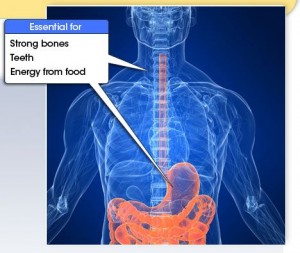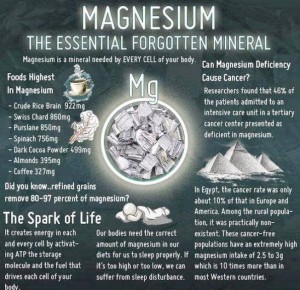Top 3 Minerals For Human Body
Calcium, Phosphorus And Magnesium Top 3 Minerals For Human Body
Calcium – the most abundant mineral in the human body
Our body contains, believe it or not, from 1 to 2.2 kg of calcium, which is the fifth consecutive element present in the human body. About 99% of it was a component of bones and teeth, mainly in the form of apatite (a mineral from class of calcium phosphate), and less in the form of calcium carbonate. The remaining 1% of calcium is circulating in the blood and participate in important functions in the body. This means that unless we bring products rich in calcium in the body, then our body “takes on the loan,” or “steal” from the bones (because there is the most abundant), which of course is reflected in the quality of bones and teeth.
So, we can say that calcium is the element that has a major role in some important functions in the body, such as:
- Participate in the formation of bones and teeth
- Normalize the exchange of water in the body and content of sodium chloride (table salt)
- Affect the acid-base balance of the body
- Affect the contractions of the muscles, especially the muscles of the heart
- It is necessary for transport of nerve impulses. He activates the action of ferments that participate in the creation of neurotransmitters (the chemical substances that regulate the transmission of electrical signals between nerve cells)
- Calcium, along with sodium, potassium and magnesium participate in the regulation of blood pressure
- Calcium regulates the process of blood coagulation
- It is necessary to transport nutrients through the cell membrane
- Improves the immune system, participates in digestion, especially in the metabolism of fats.
The best ration between calcium and magnesium is 1: 0.6. This is the ration of these two elements in sardines, black tomatoes, cucumbers, lettuce, garlic, beans, pear, apple, grapes, raspberries. The ration of calcium and magnesium in cottage cheese is 1: 0.15, in the milk is 1: 0.1, while at the bread and the meat is about 1: 2.

As for the ration of calcium and phosphorus it should be 1: 1.5. Very close to this ration we can find in cottage cheese, cucumber, garlic, grapes. In some products, such as in cheese, milk, pork, beef or chicken meat ration of calcium and phosphorus did not match the needs of the body and therefore, in addition, these products need to be consumed in combinations such as bread with cheese, meat with vegetables etc.
The daily requirement of calcium in the body depends on age. The children, whose body is in the process of growing up need 1.2-1.5 g, middle-aged people need about 1.0 g, while those with more than 50 years are needed more calcium, about 1.5 d
Where calcium is present?
Calcium is present in many products, but in some of them, he is in such a form that for the body is difficult or not possible to use. For example, from the total calcium in carrots it can be exploited only 13.4%, which means that you need to eat about 700 g carrot to be able to get the body only ¼ of the daily required amount. Who could eat so many carrots? On the other hand,calcium is well absorbed from milk and dairy products (excluding butter here). Goat milk, and thus goat cheese are richer in calcium than cow’s milk, and the daily dose of calcium in the body can be done only with 0.5 liters of goat milk or 100 grams of goat cheese. Rich in calcium are cabbage, beans, almonds. An excellent source of calcium are soft bones of anchovies and salmon.
Remember: calcium is lost by heat treatment of the products. For example, when boiling vegetables are losing about 25% of calcium and therefore you should not be throwing water in which vegetables was boiled. You can make delicious soup or it can be added in pottage.
Phosphorus – for stronger muscles
Phosphorus is the second most abundant mineral in the body and is found in every cell. Like calcium, phosphorus is important for shaping and health of bones.Over 75% of the phosphorus in the body is located in the bones and teeth.

Phosphorus:
- Stimulates muscle contraction and contributes to the growth and renewal of tissues
- Helps in creating energy for the body
- Transferring of nerve impulses
- Stimulates works of the heart and kidneys
Phosphorus in certain quantities are located in almost all products, especially meat and poultry, eggs, fish, nuts, dairy products, full grain and soft drinks.
The lack of phosphorus is rare situation- most people bring much more phosphorus than is needed, but can be caused from long-term use of antacids or anticonvulsant medications that contain aluminum hydroxide.
Symptoms of phosphorus deficiency are:
- General weakness
- Lost of appetite,
- Bone pain and
- Increased propensity for breaking bones.
Excessive amounts of phosphorus in the blood accelerate the loss of calcium, which can weaken bones.
Phosphorus poisoning is rare, except in kidney disease.
Magnesium is important for metabolism, bones and teeth
Magnesium contributes to health in many ways. Along with calcium and phosphorus is the main component of bones. The proper balance of calcium and magnesium is important for healthy bones and teeth, reduces the risk of osteoporosis, and in case of this disease relieves symptoms.

Calcium and magnesium manage muscle activity-calcium stimulates contraction of muscles, and magnesium-their loosening.
Magnesium is important for metabolism (conversion of food into energy) and the creation of proteins. Adequate levels of magnesium in the blood protect the body from diseases of the heart and blood vessels, heart arrhythmia and possibly stroke caused by a blood clot in the brain. People usually get enough (or near enough) magnesium from food.
Many antacids, laxatives and analgesics purchased in pharmacies without a prescription contain magnesium, but these drugs cannot be used as magnesium supplements. The addition of more nutrients is a relatively safe way to increase your intake of magnesium. Supplements containing only magnesium use only under medical supervision.
Magnesium needs increase during stress or illness. The addition of magnesium can help in treating of:
- Insomnia
- Muscle cramps
- Heart and blood vessel diseases, for example, high blood pressure
Studies show that the use of magnesium immediately after a heart attack increase the patient’s prospects for survival.
The organism can well processed the magnesium. The kidneys produce supplies, according to their needs, and all excess is excreted, so a lack or excess magnesium poisoning are very rare occurrences. But when it comes to, can be very dangerous. The lack of magnesium can cause:
- Nausea
- Vomiting
- Muscle weakness, and in extreme cases,
- A great reduction in heart rate and blood pressure, shallow breathing, loss of reflexes, coma and even death.



